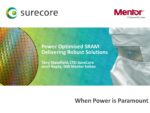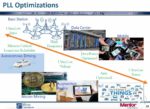Arm and Mentor Recently announced that the Arm Design Reviews program now offers Mentor help in verification design reviews. I talked to Paul Williams (Sr Consultant and Verification Practice Lead at Mentor Graphics) and Peter Lewin (Dir. Mktg at Arm Partner Enablement Group) to get more insight into Arm Design Services, particularly… Read More
Randomization Fools Us Some of the Time
Though hopefully not some of us all of the time. Randomization is a technique used in verification to improve coverage in testing. You develop tests you know you have to run, then you throw randomization on top of that to search around those starter tests, to explore possibilities you haven’t considered. Truly random tests are not… Read More
Siemens PAVE360 Stepping Up to Digital Twins
The idea of a digital twin is simple enough. You use a digital model of a car, aircraft, whatever to test design ideas and prove your design will be robust across a wide range of scenarios before you commit millions of dollars and lives to proving out the real thing. As Siemens have accomplished in their PAVE360 platform. There are a … Read More
Verifying Warm Memory. Virtualizing to manage complexity
SSD memory is enjoying a new resurgence in datacenters through NVMe. Not as a replacement for more traditional HDD disk drives, which though slower are still much cheaper. NVMe storage has instead become a storage cache between hot DRAM memory close to processors and the “cold” HDD storage. I commented last year on why this has become… Read More
Trusted IoT Ecosystem for Security – Created by the GSA and Chaired by Mentor/Siemens
There’s a lot to keep you awake at night these days. If you live in California, it’s wildfires and unbreathable air. If you live on planet Earth, it’s COVID-19. And if you’re part of the value chain for IoT, it’s the security and robustness of the silicon and software fabric that connects our world. This fabric connects everything,… Read More
Emulation as a Service Benefits New AI Chip
It’s no secret that innovation in AI chip architectures is on a tear. When you put together the spatial complexity of highly parallelized algorithms with the need to localize memory accesses on-chip to the greatest extent possible, we’re seeing a proliferation of all kinds of domain-specific architectures. Which in the normal… Read More
WEBINAR: Addressing Verification Challenges in the Development of Optimized SRAM Solutions with surecore and Mentor Solido
After spending a significant amount of my career in the IP library business it was an easy transition to Solido Design. I spent 10+ years traveling the world with CEO Amit Gupta working with the foundries and their top customers. In fact, the top 40 semiconductor companies use Solido. IP companies are also big Solido users including… Read More
Creating Analog PLL IP for TSMC 5nm and 3nm
TSMC’s Open Innovation Platform’s main objective is to create and promote partnership for producing chips. This year’s OIP event included a presentation on the joint efforts of Silicon Creations, Mentor, a Siemens business and TSMC to produce essential PLL IP for 5nm and 3nm designs. The relentless push for smaller geometries… Read More
Getting Physical to Improve Test – White Paper
One of the most significant and oft repeated trends in EDA is the use of information from layout to help drive other parts of the design flow. This has happened with simulation and synthesis among other things. Of course, we think of test as a physical operation, but test pattern generation and sorting have been netlist based operations.… Read More
White Paper – Mixed Signal Verification for Nanometer SOCs
The number of touchpoints between analog and digital circuits in high performance SoCs is increasing. This is not a problem because it is possible to implement critical analog blocks directly on nanometer scale digital ICs. However, in many cases digital interfaces or digital feedback circuitry configures these analog blocks… Read More










